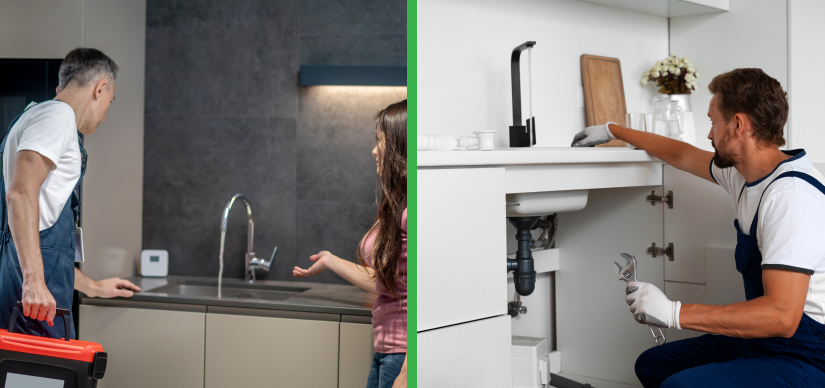Four Typical Issues with Kitchen and Bathroom Faucets
Working in a kitchen presents some common faucet-related issues. By leveraging some DIY hacks, you can easily get rid of these issues; however, it is also important to understand that such incidents can be easily avoided through prevention.
Let us understand these common issues to avoid repeated sink and faucet repair situations. Read further to know more.
1. Leaking Faucet:
Many factors cause a leak and leave your faucet dripping.
The main reasons for leaking faucets are the caking of salts, minerals, and corrosion over time, which exposes the washers. The washers are the protector of the faucet.
- Tired and old washers or gaskets may get worn out.
- O-rings may get cracks and dry out over time.
- The washer surfaces may press against each other, and they won’t seal properly.
Sink and Faucet Repair for Leaks
- Based on the root cause of the problem, an effective solution can be implemented.
- If any plumbing problem is encountered, the main water supply should be turned off. Disassemble to examine the washers, O-rings, and valves for wear and tear. Buy a new one with the right size to ensure it fits properly.
- If there are mineral deposits, clean them using a vinegar solution (3 parts vinegar and 1 part water).
If the leak does not go away and you cannot identify the inner cause, replace the entire faucet or a specific part. Call a professional for faucet installation near San Diego.
Preventive Tips:
- To increase the faucet life and prevent repairs, it is important to perform regular faucet maintenance services and inspections.
- Clean the aerator, skip the harsh cleaners, and be quick to fix leaks—your faucet will thank you with a long, happy life.
- Turn off the water supply before any repairs to avoid accidents.
2. Low Water Pressure:
A weaker or slower flow of water than its optimal speed from a faucet is low water pressure. The causes of low water pressure are the building up of sediment, clogging of the aerator, and issues with the water supply line.
You may identify the cause by checking all the faucets for water pressure. Other causes include failed pressure regulators, leaks in the plumbing system, and municipal water supply problems.
Repair Measures
- To clean the aerator, remove the faucet and soak it in vinegar so that the mineral gets dissolved.
- A faulty pressure-reducing valve needs to be replaced. Hire the best local San Diego Faucet Repair Installation services to clear the clogs and other persistent issues.
- Test and replace the pressure regulator if it is not functioning correctly.
- Further, problems in identification and non-resolution of the issue on your own should be consulted with a licensed plumber.
Preventive Measures:
- Regularly inspect and maintain the faucets and aerators. Use drain screens to prevent debris from entering the plumbing system.
- Inform family members and other occupants to use the faucet properly and to avoid non-biodegradable items.
An annual inspection through a flawless shower faucet repair in San Diego could help assess persistent low-water pressure problems.
3. Handle Issues:
With time, the faucet undergoes wear and tear of the faucet and its internal components. Gradually, the handle becomes loose.
The handle wobbles as the set screw that is attached to the handle of the faucet becomes loose or damaged.
Corrosion of the screw threads and other components is another factor responsible for loose handles. High water pressure increases the wear and tear of the faucet, making the handle and faucet components loose. Here is when the role of the pressure regulator comes in as it maintains optimal pressure.
Using excess force while turning the handle for opening and closing loosens the internal components. This is why faucets opening and closing should be gentle.
Repair Measures:
- For single-handle faucets, locate the set screw, often under a decorative cap, and tighten it using a screwdriver or Allen wrench. If the handle is severely damaged, it’s usually best to replace it.
- Attach the new handle according to the manufacturer’s instructions. This may involve securing it with a set screw or other fastening mechanism.
- Examine the internal components for signs of wear. If you notice significant wear, consider replacing worn parts or the entire cartridge.
- Apply a small amount of lubricant, such as plumber’s grease, to the moving parts to reduce friction and prevent future issues.
Preventive Measures:
- Inspect the handle components such as the cartridges, O-rings, and washers. Identify and replace the damaged or worn-out parts.
- Check the faucet for water leaks after reassembly. All connections should be tight.
If the repair process seems extensive, consider seeking professional assistance for repair or new faucet installation in San Diego.
4. Noisy Faucet:
Loose nuts, screws, or washers from the loose and damaged components contribute to the noisy faucets. Worn-out washers also create vibrations making noise during water flow. Inadequate water flow or a faulty aerator can induce emissions from your faucet. Identifying the specific issue, such as loose parts or mineral buildup, allows for targeted repairs, ensuring a quieter and more efficient faucet in both kitchen and bathroom settings.
Repair Measures:
- Tighten handles, screws, and any loose parts to minimize noise.
- If the issue persists, try to identify and address the root cause of the issue. Inspect and replace damaged parts, such as the washer or other internal components.
- Lubrication is an effective solution for noises caused due to moving parts. A silicone-based grease helps minimize noise.
- If DIY repairs seem unreliable, faucet repair and installation in San Diego should be fixed using a professional plumber.
Preventive Measures:
- Check for Loose Parts: Tighten any loose components like handles or connections to reduce vibrations.
- Inspect Water Pressure: High water pressure can cause noise; consider installing a pressure regulator.
- Examine Pipes: Secure loose pipes to minimize vibrations and noise transmission.
If the repair process seems extensive, consider seeking professional assistance for repair or new faucet installation in San Diego.
Conclusion
Kitchen and bathroom faucets undergo wear and tear faster. Most of these issues, if identified earlier, can be prevented from becoming bigger problems. Common problems such as leaky faucets, low water pressure, handle issues, and noisy faucets can be handled through DIY repairs. Addressing these typical faucet issues promptly can help prevent many sink and faucet repair issues and maintain a functional and efficient kitchen or bathroom plumbing system.


